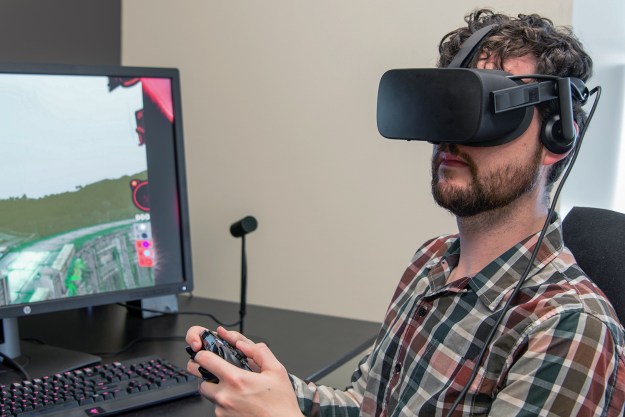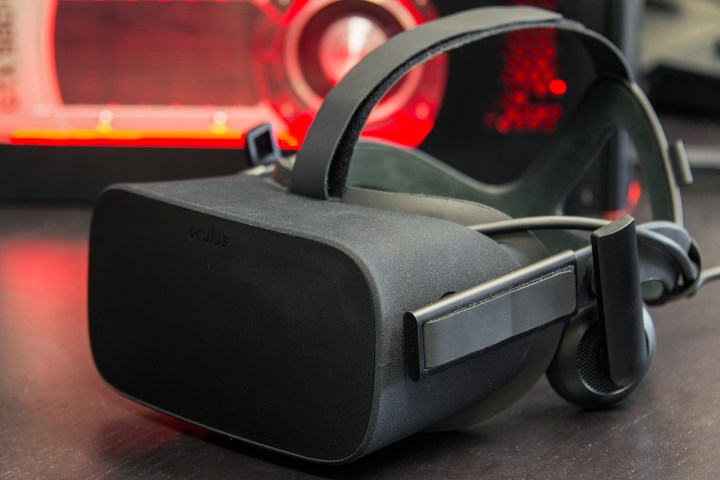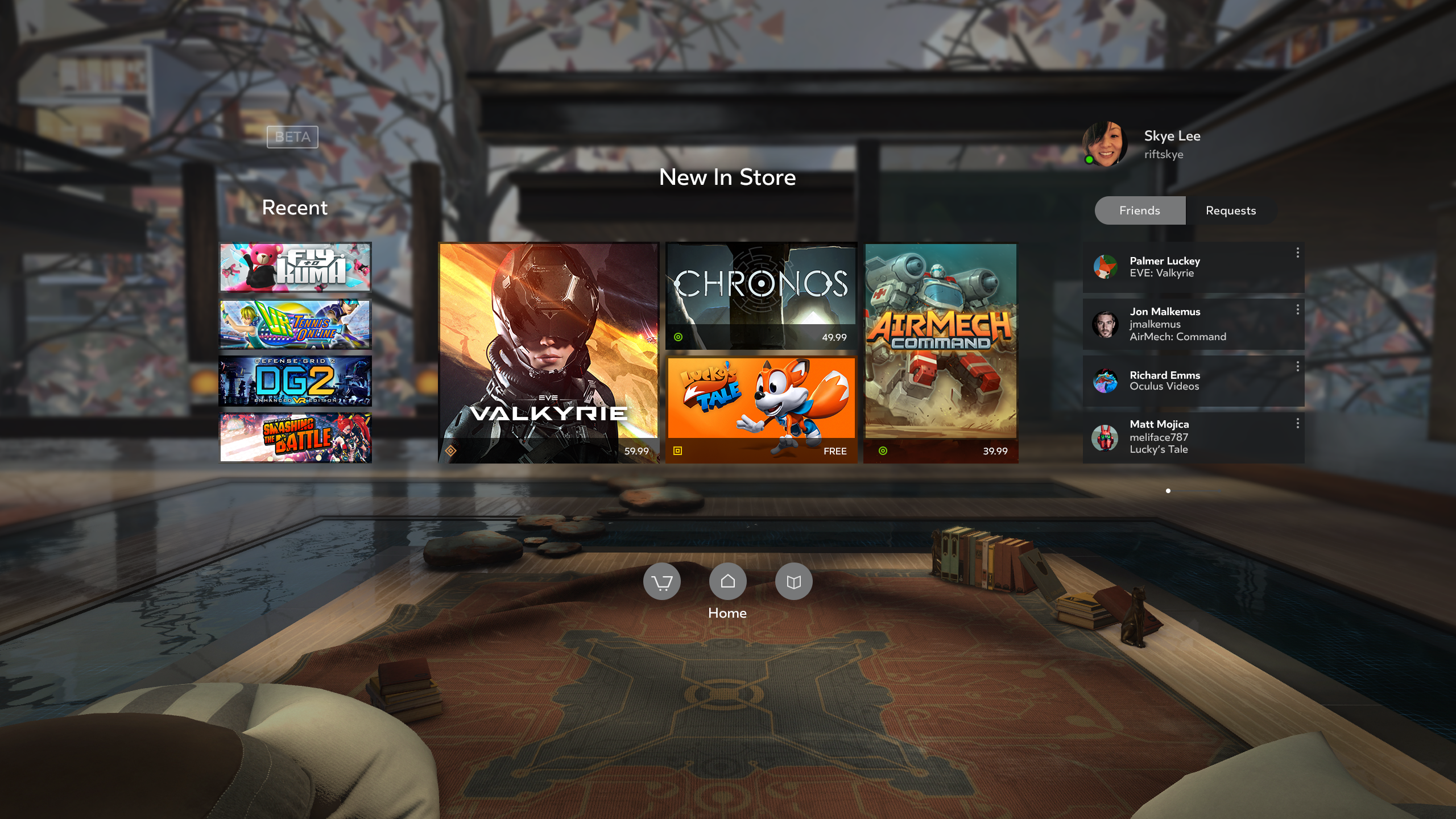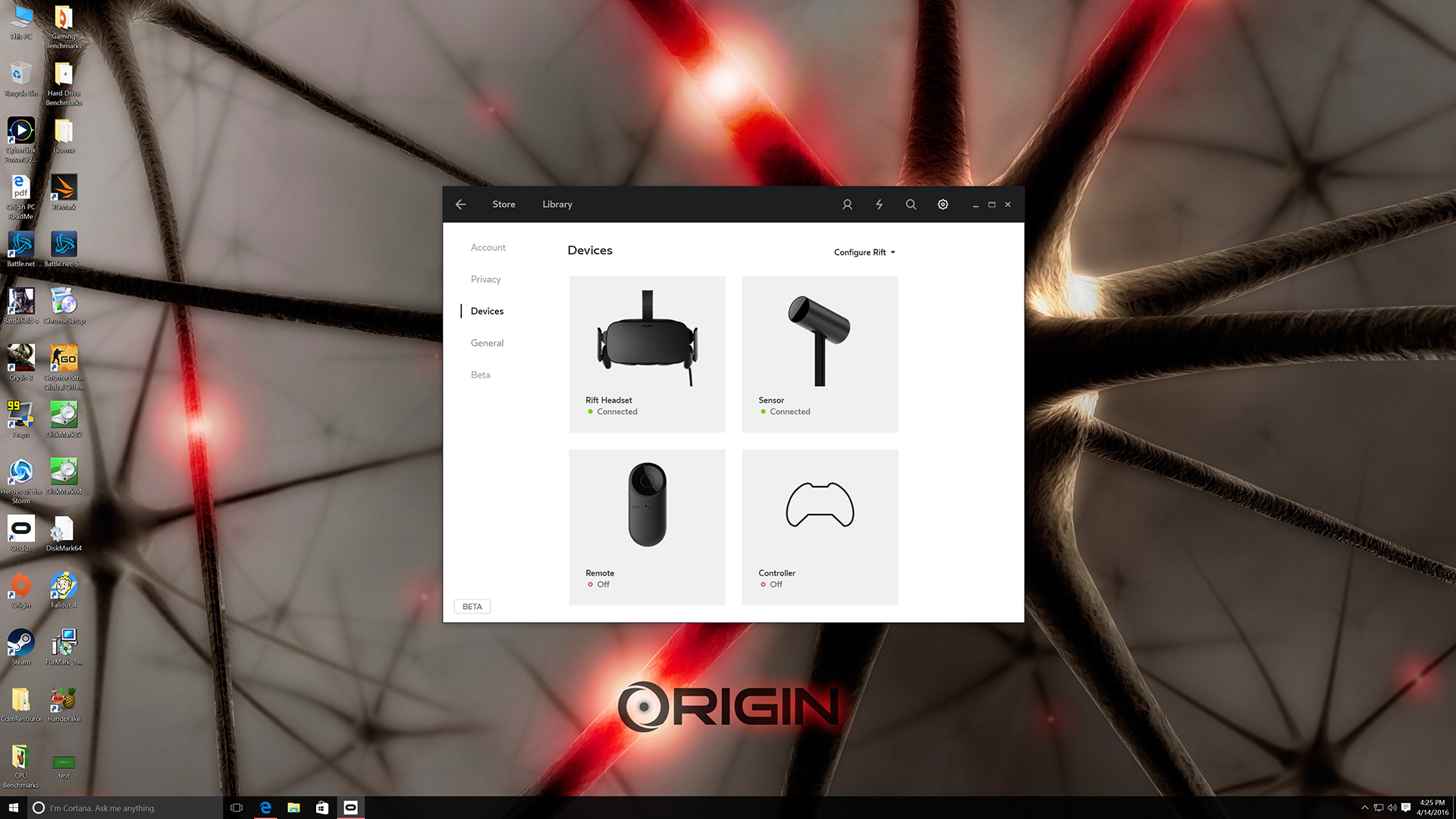
“The Oculus Rift is a glimpse at the future, but it doesn't always work as it should”
- Refined design
- Headset is comfortable for most
- Easy to setup and use
- Touch controllers feel great in-hand
- Motion sickness is an issue when sitting
- Oculus Home is a mediocre platform
- Touch controllers can be unreliable
On the first day of August, 2012, Oculus launched its Kickstarter. In doing so it started not one, but two revolutions. The project’s massive success proved people wanted to give virtual reality another shot, and showed Kickstarter can lift the fortunes of not just an entire company but an entire category of products. The 2.4 million dollars raised by Oculus seems paltry compared to more recent crowd-funded projects, but it put the company on sound footing, and led to its eventual acquisition by Facebook for a cool two billion.
Oculus needed the backing. Its Kickstarter was launched almost four years before the product hit store shelves. That’s a long time for a product to be in development, and in that time Oculus launched several developer kits. The retail edition has been around for two years now and anyone can buy it. After a deep price cut too, the Oculus Rift package can be picked up for just $400. That includes the headset, the controllers, two external sensors, and a couple free VR games.
HTC’s Vive is a strong competitor, and there’s a number of less expensive headsets based on mobile hardware, including the stand-alone headset Oculus Go. Even with a deep discount, is the Rift still worth your time? Let’s find out.
A work of art
You’d expect almost four years of development to result in a refined product and that certainly describes the Rift. HTC’s Vive looks like a prop designed for a B-list cyberpunk film. The Rift is something you’d be proud to have on your desk.
The Rift’s hardware and design surpasses even HTC’s Vive.
Fabric is the key to its design. It covers almost the entirety of the head-mounted display, as well as a triangle on the rear of the headband. The fabric looks opaque, but is transparent to infrared light, which lets Oculus hide its internal sensors. While the Rift appears sleek, with few individual components, it’s crammed full of hardware.
Its hardware quality is on par with the design, and surpasses even HTC’s Vive. Every part feels light, yet durable, and seems tightly screwed together. The straps are more rugged than with competitors, though they’re also smaller, and even the padding seems more rugged. Some testers found that last point a problem, because the Rift feels rougher and tighter than competing headsets. But the padding holds up better than the Vive’s, which became discolored almost immediately.
Designed for comfort
The broad strokes of the headband’s design are similar to other headsets. There are two side straps, and one over-head strap, which connect to a triangular support that grips the rear of your head. But the Rift’s straps operate more smoothly than most, which means adjustments require little force, and strap tension is better tuned to make the Rift simple to put on or take off.
Most testers found it more comfortable than HTC’s Vive, though there was some dissent. Those who liked the Rift better unanimously cited its weight. It felt like less of a burden than any VR headset we’ve tested, including the Samsung Gear VR, and shifted little when testers moved to and fro.
Those who disagreed about the Rift’s comfort felt it was too narrow, or sat awkwardly. One tester remarked the Rift “feels more like a hat, while the Vive felt more like a helmet.” Everyone agree that the Rift’s face padding felt unforgiving, and most testers noticed light leaking in from the bottom of the headset.
Just one cord connects the Rift to the PC. It’s shorter than the Vive’s cord, since the Rift is designed primarily for a seated experience in a smaller area. Strangely, the cord shoots off to the left, rather than off the center. That’s probably meant to make the run towards the PC shorter, but it only really pays off if you normally have your computer sitting to your left. It also feels less natural to have a cord dangling across one shoulder rather than straight down your back.
That’s a minor miss, though, and ultimately a single cord (which splits at the end into two – one HDMI, one USB) is far easier to manage than the Vive’s massive cord bundle. The Rift also has just one external IR sensor, a small device that sits on a desk. It’s a cinch to set up and doesn’t demand you re-arrange your entire room to accommodate it (yes, technically you can use the Vive as a sitting headset — but that’s missing the point).
A good first impression, but get a bucket ready
While the Rift’s initial comfort was excellent, motion sickness quickly became a problem. All six of our testers reported discomfort. For some, it was little more than a lingering sense of vertigo. For others, the problem was so bad it meant putting the headset down after a few minutes of play.
The general rule is this; games that attempt to move the player are likely to cause trouble.
Lucky’s Tale, a platformer played from a god-like perspective, was the most comfortable. Eve: Valkyrie upset a few stomachs, but half of our testers had no issue. Over the months, we’ve tested many other experiences ranging from Serious Sam VR to Rescuties. The general rule is this; games that attempt to move the player, and especially those that flip or turn the player’s perspective quickly, are likely to cause trouble. Other games smartly leave the player in a relatively static position, or find other ways to move them, which means less motion sickness.
Oculus tries to remind players of this with a “comfort” rating on each game or experience. We’re not sure who sets this, and it didn’t provide a useful warning. We found The Climb comfortable, despite its “intense” rating. Minecraft Windows 10 Edition, rated as “moderate,” is the most uncomfortable VR game we’ve ever played.
Out of control
The Xbox controller caused some complaints. It’s a great gamepad, but it doesn’t always fit the situation well in VR. Grasping a controller in Eve: Valkyrie feels odd when your virtual avatar is clearly grasping a pair of joysticks. Users without previous experience with it will run into major problems, since there’s no way to see the controller while using it in most games. The Rift assumes a certain level of muscle memory, and if you don’t have it, you’ll be fumbling at the buttons hoping to find what works.
While all VR headsets cause some disorientation, the Rift is the worst we’ve tested. The problem seems to be the combination of fast-paced, visually stimulating titles, and a seated experience.
Oculus’ Touch controllers, which let users interact directly with VR games and experiences, offer a much more intuitive interaction method. They work in conjunction with a second sensor station, also provided with the controllers. Adding Touch, which is now bundled with the Rift, has made motion sickness less of a problem – but they’re not without troubles of their own.
Though easier to set up than the HTC Vive’s controllers, and a bit more comfortable, Touch suffers from poor tracking and lackluster room-scale. The problem is the sensor technology, which is easier to obstruct and confuse than the Vive’s Lighthouse sensors. Check out our full review.
Like a cat stuck behind a screen door
The Rift has an effective total resolution of 2,160 x 1,200 pixels. That sounds like a lot. But a VR headset places the screen just one or two inches away from your eyes, which makes pixels easy to pick out. Some companies, like AMD, say fully immersive VR must pack up to 116 megapixels — around double 8K resolution — into a phone-sized display. We’re a long way from that standard and even further from being able to power it.
Clarity, while far from perfect, wasn’t a major issue. Most games looked crisp enough to remain impressive, though the overall effect was more akin to playing on a weaker 720p monitor than a modern 1440p or 4K display. But what it lacked in sharpness it makes up for with a 90Hz refresh rate and extremely effective stereoscopic 3D. The display provided an excellent sense of depth in every game and experience we tried.
The real problem was the dreaded “screen door effect,” a pattern of visible lines in the picture. Pixels have gaps between them, and when the gaps are too large (relative to viewing distance), they’re visible. Old computer displays often had this problem, but it went away as pixel density increased. Now, it’s back.
The “screen door” was especially distracting in bright scenes. To be fair, though, every current VR headset suffers the problem to some degree. The Vive Pro may reduce it, but that headset is more than two times the price of the Oculus Rift.
And we noticed another problem, one we’ve not witnessed elsewhere. In dark scenes the Rift’s display had a distracting “sparkling” effect, which seems to be caused by uneven pixel brightness. A black scene is never dark, nor evenly lit; instead, multiple grainy points of light appear. It looks a bit like a bad film-grain Photoshop filter.
Your ears are treated better. The Rift’s built-in headphones are comfortable, reasonably loud, and not in-ear. That latter point is a benefit. With in-ear headphones, as used with some competitors, it’s hard to hear what’s nearby. A rabid badger could attack your friend just a few feet away, but you’d never know. Over-ear headphones provide a better sense of what’s nearby in real life without ruining your virtual immersion.
Just what you wanted – another software storefront
Setting up the Oculus couldn’t be easier. A card in the box directs you to the Oculus website, where you can download the installer. Once launched, a slick visual wizard guides you through each step. The process takes less than 10 minutes.
After setup, you’re directed to a few brief demos before you’re plopped into your Oculus Home – which is basically the Oculus Store. As with the Gear VR and the Vive, the Rift goes hand-in-hand with a specific digital storefront. Technically, it can be used outside of it. You can use the Rift with a SteamVR copy of Elite: Dangerous, for example. But the Rift is built for the Oculus Store, and you’ll have an easier time if you stay within it.
The Oculus Home menus are intuitive. Your gaze acts as a mouse cursor while the gamepad buttons are used to select or retreat from menu screens. A selection of three buttons always hovers at the bottom of the viewing area, ready to send you to your library, home screen, or the store. This gets even better if you have the Touch controllers, which let you directly point to and select menu items.
SteamVR isn’t confusing, but it’s not quite as easy to navigate. The difference probably has more to do with design than with execution. Oculus Home is smaller in scope. It’s not hooked into a wider ecosystem of desktop games, and doesn’t have as many features in Steam, though Oculus has improved the Rift’s social features since launch, including the Rift Core 2.0 update which brought customization to the Oculus Home experience.
It makes Home a more robust VR experience. You can decorate a virtual room with trophies, items, furniture and windows that look out into space. You can also invite friends to your Home to come and hang out or play compatible games.
The Oculus Dash introduces a seamless overlay for your VR experiences, allowing you to pull up the store, friend list, and web browser without leaving your VR game or experience.
There’s nothing wrong with Home, but there could be more right.
The in-headset Home interface isn’t the only way to interact with the store and library, either. There’s also a sleek, simple desktop application. It’s as limited as Home, but at least provides a way to view the store, purchases, settings, and downloads outside of the headset. Being forced to slip on the headset just to shop would’ve been a pain.
There’s nothing wrong with Home, but there could be more right with it. Steam is familiar, and it’s the defacto gaming platform for a lot of gamers. Oculus’ decision to ignore it for a less functional proprietary alternative is sure to annoy gamers already tired of managing a roster of logins for various hardware platforms and game publishers. Despite improvements since launch, Home still doesn’t quite feel like, well, Home.
Fortunately, the Oculus Rift has also recently been added as a supported headset on Viveport, opening up a larger library of games and experiences to be had.
The games are coming
Both the Oculus Rift and HTC Vive dealt with unimpressive launch games. We saw a few standout titles, like Fantastic Contraption, but the biggest games were simple ports of titles previously available on desktop PCs.
That’s no longer true. Several appealing games have been developed either exclusively for VR, or with VR as the primary platform. Examples include Arizona Sunshine, Robinson: The Journey, Operation Apex, The Climb, Superhot VR, and I Expect You To Die.
There’s still a gap between the quality of VR titles and mainstream AAA games, and there’s still no virtual reality equivalent to The Witcher 3 or Halo. Even these games are limited in focus, and most offer perhaps 10 to 20 hours of content. Arcade-style games that rely on a satisfying gameplay hook are more common than games that attempt a deep story.
The variety of titles available for Rift has benefited from the introduction of the Touch controllers. Though not identical to the Vive’s controllers, they’re similar enough to make porting from Rift to Vive, or the opposite, relatively simple. A number of Vive-only games have appeared on Rift in recent months, and that has nicely bolstered the headset’s selection. It now has access both to Oculus exclusives and many successful Vive games.
And note, we’re not talking about using the Rift with SteamVR. Many games have been ported right into the Oculus Store, making them simple to install and play.
Our Take
Oculus’ Rift is the realization of a dream for many geeks. Virtual Reality headsets are finally available for purchase. All you need is a powerful computer. Yet the Rift still needs to mature. Technical quibbles and controller limitations hold it back from greatness.
Is there a better alternative?
Yes, the HTC Vive. It offers a similar library of games and superior motion controllers that can be used in larger spaces, though it can also be used while sitting. You can also consider the Vive Pro, which is far more expensive, but offers higher-resolution displays and a more comfortable fit.
In addition, the Oculus Go is a stand-alone headset that comes in cheaper than the Rift. Although it’s not quite as immersive as the Rift, it has everything you need right in the headset and doesn’t require a gaming PC.
How long will it last?
Oculus’ current strategy appears to be more mid-range focused with prototypes like the Oculus Santa Cruz, so it may be some time until we see a true Rift 2.0. That should mean that the Rift remains relevant for some time, but if you want a more advanced piece of hardware, the Vive Pro is arguably the most impressive commercial VR headset available today.
The Oculus Rift ships with the usual one-year warranty, which is the same as every other VR headset so far.
Should you buy it?
No. We still like the Vive better. You might find it’s worth an extra $100 if you’re interested in full room-scale VR experiences. We prefer the Vive’s software support and find its motion controllers more reliable. That said, the $500 Vive is more expensive, and the Rift works as a budget alternative.
You should buy the Rift if you want a decent VR experience now — and at a reasonable price. The Rift has limitations that hold back the experience, but the recent price cut makes it a more palatable purchase. For just $400, you get the VR headset, the controllers, a couple of external sensors, and a handful of VR games.
Editors' Recommendations
- The best games on Meta Quest 3
- The best PSVR games for 2023
- PlayStation VR2 will include see-through view and broadcasting options
- What the Golf? sequel, Twilight Zone VR, and more shown at UploadVR stream
- Among Us VR, Ghostbusters, and more coming to Meta Quest 2













